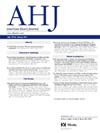经导管主动脉瓣置换术后直接口服抗凝剂与华法林的临床结果:来自STS/ACC TVT登记
IF 3.7
2区 医学
Q1 CARDIAC & CARDIOVASCULAR SYSTEMS
引用次数: 0
摘要
背景:经导管主动脉瓣置换术(TAVR)受者经常有长期口服抗凝的适应症,包括房颤或系统性血栓栓塞性疾病。目前尚不清楚直接口服抗凝剂(DOAC)和华法林在该患者群体中的安全性和有效性是否存在差异。方法:使用胸外科学会/美国心脏病学会经导管瓣膜治疗(TVT)注册与医疗保险和医疗补助服务中心索赔数据相关联的数据,比较接受DOACs或华法林的TAVR受者的临床结果。该分析包括来自TVT登记处的患者,他们在2013年1月至2018年5月期间接受了成功的TAVR,并使用DOAC或华法林出院。主要结局为出院至1年内是否有出血需要住院治疗。次要结局包括出院至1年的全因死亡率和卒中。采用多变量Cox比例风险回归模型比较两组间的结果。结果:共有29142例患者接受TAVR治疗并口服抗凝出院,其中10973例(37.7%)患者接受DOAC治疗出院。在整个研究期间,doac的使用量增加,到最后一年(2018年)超过华法林的使用量。一年内需要住院治疗的出血累积发生率(11.8% vs. 15.2%)。结论:在美国一个大型登记中心对口服抗凝剂出院的TAVR受者的分析中,使用DOAC而不是华法林与出院至1年内出血需要住院、全因死亡率和卒中的风险较低相关。未来的随机研究将有必要确定TAVR患者抗凝剂的最佳选择。本文章由计算机程序翻译,如有差异,请以英文原文为准。
Clinical outcomes of direct oral anticoagulant versus warfarin after transcatheter aortic valve replacement: From the STS/ACC TVT registry
Background
Transcatheter aortic valve replacement (TAVR) recipients frequently have an indication for long-term oral anticoagulation, including atrial fibrillation or systemic thromboembolic disease. It remains unclear if there are differences in safety and effectiveness between direct oral anticoagulants (DOAC) and warfarin in this patient population.
Methods
Clinical outcomes were compared between TAVR recipients receiving DOACs or warfarin using data from the Society of Thoracic Surgeons/American College of Cardiology Transcatheter Valve Therapy (TVT) registry linked with Centers for Medicare & Medicaid Services claims data. The analysis included patients from the TVT registry who underwent successful TAVR and were discharged on either a DOAC or warfarin between January 2013 and May 2018. The primary outcome was any bleeding requiring hospitalization from discharge to 1 year. Secondary outcomes included all-cause mortality and stroke from discharge to 1 year. Multivariable Cox proportional hazards regression models were used to compare these outcomes between the 2 groups.
Results
A total of 29,142 patients underwent TAVR and were discharged on oral anticoagulation, among whom 10,973 (37.7%) were discharged on a DOAC. The use of DOACs increased throughout the study period and exceed the use of warfarin by the final year (2018). The cumulative incidence of bleeding requiring hospitalization at 1 year (11.8% vs 15.2%, P < .001) and all-cause mortality (15.5% vs 17.5%, P < .001) was significantly lower in DOAC group while stroke (2.47% vs 2.39%, P = .64) was not statistically different between groups. In an adjusted model, the use of a DOAC as opposed to warfarin was associated with a significantly lower risk of bleeding requiring hospitalization (adjusted hazard ratio 0.49, 95% confidence interval 0.43-0.56), all-cause mortality (adjusted hazard ratio 0.61, 95% confidence interval 0.57-0.66), and stroke (adjusted hazard ratio 0.86, 95% confidence interval 0.81-0.92) (all P < .001).
Conclusions
In this analysis of TAVR recipients discharged on oral anticoagulation in a large U.S. registry, the use of a DOAC rather than warfarin was associated with a lower risk of bleeding requiring hospitalization, all-cause mortality, and stroke from discharge to 1 year. Future randomized studies will be necessary to establish the optimal choice of anticoagulant in TAVR patients.
求助全文
通过发布文献求助,成功后即可免费获取论文全文。
去求助
来源期刊

American heart journal
医学-心血管系统
CiteScore
8.20
自引率
2.10%
发文量
214
审稿时长
38 days
期刊介绍:
The American Heart Journal will consider for publication suitable articles on topics pertaining to the broad discipline of cardiovascular disease. Our goal is to provide the reader primary investigation, scholarly review, and opinion concerning the practice of cardiovascular medicine. We especially encourage submission of 3 types of reports that are not frequently seen in cardiovascular journals: negative clinical studies, reports on study designs, and studies involving the organization of medical care. The Journal does not accept individual case reports or original articles involving bench laboratory or animal research.
 求助内容:
求助内容: 应助结果提醒方式:
应助结果提醒方式:


